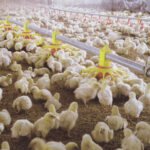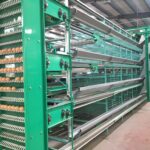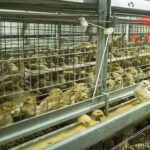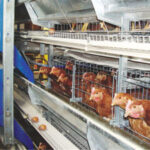How to use the chicken cage for feeding management?
1.Nursing points
The indoor temperature should be strictly controlled. Before entering the chick, the room temperature is about 30 °C, and after entering the chick, the room temperature gradually rises to about 33-35 °C. It is best to broil broiler chickens in the uppermost layer, with 27-30 broods per cage. Fill the cage with the small tray in advance. The water tank is pre-heated in order to pre-warm (consistent with the indoor temperature). After the chickens arrive, quickly place the chicken box into the room, place it evenly, and then count the cage. 3 to 5 days before brooding. Drinking water should be added: glucose, astragalus polysaccharides, antibacterial drugs, and electrolysis. The purpose is to restore the chicks’ physical strength, relieve stress, kill the vertically-transmitted pathogens, promote the development of immune organs in the chicks, and improve the disease resistance of the chickens.
2. Chicken feeding management
It is best to feed every morning. It is better to use 3 times for 1 day in the house with automatic feeder. When using the trough, the artificial feeding should be added evenly and feed in time. Prevent the chicken from being trampled due to hunger and food. The breeder checks whether there is an empty trough every afternoon and should replenish it in time. The feeding situation of the trough should be checked by the technicians every day. When there is more material left, it is necessary to take timely measures. Analyze and judge the possible situation: there are fewer chickens in the cage, and should be replenished in time. Check if the nipple is short of water and if there are any sick chickens in the cage. Individual treatment or elimination should be picked out in time. Whether the lighting is insufficient, we must take timely measures to make adjustments.

3. Drinking water management
Should guarantee 24h normal water supply. Water control is required in addition to medication or seedlings. Always check the water line for blockages, which is a critical issue for each farm. Early detection is required. The nipple leaks water, the water that flows out wastes the drug, and it enters the septic tray to dilute the faeces and then flow into the trough. First, it will waste feed, and second, it will cause intestinal diseases.
4. Temperature and humidity management
The humidity during brooding should generally be around 65-70%. After that, the humidity gradually decreases, which is about 60%. Cage broilers are indoors (especially where the boiler chimney passes), and it is prone to lack of humidity. It is best to take a warm water spray with chicken disinfection. If the humidity is too high, increase the temperature and increase the amount of ventilation.
5. The temperature follows the principle of “constant and smooth transition”
The brooding temperature is generally between 33 and 35 °C. According to this benchmark, as the age of the chicken grows, it drops twice a week and cannot be cold and hot. Technicians and breeders should always pay attention to the weather changes, keep abreast of the outside temperature, and adjust the ventilation according to the required temperature. Chickens need a suitable temperature for rapid growth. To grow faster, the temperature is relatively high.
6. Ventilation management
Ventilation and ventilation is an important part of the breeding process. Ventilation begins in the first week. Open the sunroof, and some of the side windows should be opened moderately. The sealing should be angled upwards. When the temperature is guaranteed, the ventilation should be increased appropriately. As the age increases, the amount of ventilation gradually increases. When approaching 20 days of age, the longitudinal fan needs to be opened, because the ventilation of the side window is small and cannot meet the needs. According to the required ventilation volume, external temperature, season, indoor air quality, the governor should be installed. The speed and duration of the fan should be changed according to the specific conditions. Can not be too much air, otherwise the chicken will only cause a cold. If the weather is abrupt, the wind is too large and the side windows should be temporarily closed.
7. Timely grouping
The first time the poultry farm battery cage is to be carried out at 10 days of age. If the cage is too late, the chicken will grow unevenly, and the weak will be crushed to cause death. The cage is too early and the bottom layer temperature is low, which is not good for growth. For the first time, the first cage is divided into 9 to 10 from the upper layer to the middle layer. The second time, the cage is divided, and then 9 to 10 are separated from the upper layer to the bottom layer. The time of grouping depends on the growth of the respective flocks.











